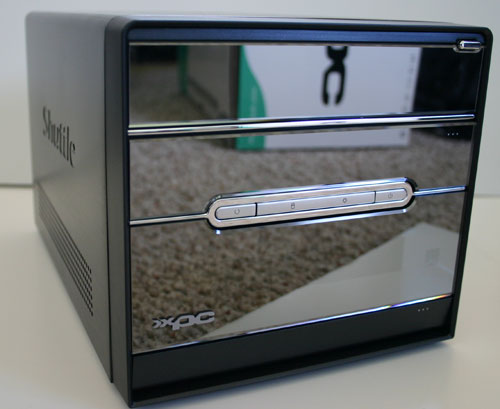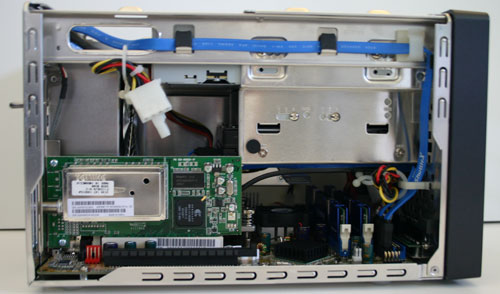Microsoft's Portable Media Center Devices: Exposed
by Anand Lal Shimpi on September 27, 2004 12:05 AM EST- Posted in
- Smartphones
- Mobile
Getting Sidetracked: Shuttle's new MCE XPC - The Perfect Testbed
Since we wanted to test the new Portable Media Center devices on a Windows XP Media Center Edition system, this was the perfect opportunity to try out Shuttle's latest and greatest XPC - the SB83G5C.
The new G5 chassis is much improved from previous Shuttle designs, yet still maintains the form factor and beauties that made the XPC so popular. This particular model has a LCD display at the front that interfaces to MCE2004 to display date/time as well as playback information.
The G5 8300 series uses Intel's 915G chipset and supports all of Intel's Socket-775 processors. While our particular sample relied on the 915G's integrated graphics, Shuttle usually ships their XPCs with a PCI Express GeForce 6600 to make it more of a gaming powerhouse. Remember that by using the 915G chipset, there is no AGP slot on the motherboard, only a single PCI Express slot in addition to the regular 32-bit PCI slot. And as with all Shuttle XPCs, the system can only support a single slot graphics card.

The system has a linearly controlled fan that remains quiet for the vast majority of the time; however, transcoding content for synchronizing to the PMC did cause things to heat up and the fan to spin faster/louder. Since the fan is linearly controlled, there are no noticeably discrete steps in fan speed. It gradually increases until the desired temperature has been reached.
The inside of the system is very clean and neat, thanks to Shuttle's clever engineering. There is virtually no cable clutter in the pre-assembled system due to the use of a proprietary Shuttle-designed interface to the front of the case and Serial ATA for both the hard drive and DVD drive.
Our test sample was paired with a Pentium 4 550 (Prescott running at 3.40GHz), which left the system's fan running fairly quiet despite its heat production. Given the extremely high CPU demands of Windows XP Media Center Edition, using such a fast processor is necessary to minimize the response time of the media center application. As to why MCE is such a CPU hog, that's more of a question for Microsoft - one to which we have yet to find an honest answer.
When it comes to MCE PCs, Shuttle has the right formula - these machines need to be small and they need to look like they fit in a living room. With the advent of the BTX form factor and with Windows XP MCE 2005 coming out, the competition is definitely looking towards more out-of-the-box designs for MCE PCs, putting the burden on Shuttle to once again innovate. What we're still waiting to see from Shuttle is another revolutionary design, similar in impact to what made the XPC what it is today - until then, we can't complain about the evolution that the design has seen since its creation.










18 Comments
View All Comments
Reflex - Thursday, September 30, 2004 - link
http://news.com.com/Microsoft+focuses+on+camera+co...Thats the announcement on MTP. Its an open standard and anyone can support it. Its NOT tied to Windows Media Player 10.
crepticdamion - Wednesday, September 29, 2004 - link
Hello, it seems some people know more than AnandTech concerning this article.There are other MUCH better solutions that are not from Microsoft. I don't have anything against Microsoft (even had a lot of PocketPC generations and still have 2 PocketPCs) but when the Microsoft product is worse than the others, well I won't have it because is Microsoft. With me, the better product (overall) always wins.
Put that apart, this PMC is completely so MUCH weaker than Archos AV400 product, that my heart screams with indignation regarding this article. The diference in Size, Weight, Performance, Capacity (AV480 has 80GB, while AV420 is 20GB as PMC), and what Archos does more is infinite. Microsft ALWAYS looses.
I advise everyone that read this article to go search on Yahoo or Google for an Archos AV400 Review. Your mind will be boggled with its capacities and it is already available.
Archos AV400 is several years ahead of everyone else in these products and they deserve it, they've been working on this for almost a decade.
Good Hunting and always compare the alternatives.
Pjotr - Tuesday, September 28, 2004 - link
#14, That's why the Archos is so much better.Wizkid - Tuesday, September 28, 2004 - link
That hard drive is capable of 16MB/sec minimum. The rediculously slow transfer rate must be a software or implementation issue.mindless1 - Monday, September 27, 2004 - link
Transcode the video?I think I'll wait for a non-crippled PM player.
ViRGE - Monday, September 27, 2004 - link
At 320x240 and 10MB/min needed for the best video quality, it seems Microsoft is working way too hard here. Those specs are right around the sweet-spot for MPEG1 of all things, which is fast & easy to encode and decode, and at such a low resolution would return very similar results. Obviously MS is planning for the future here, and on that note, these devices will be much more notable once they start using full VGA screens instead of QVGA.michael2k - Monday, September 27, 2004 - link
Hmm, I call.This thing can only do 2MB/s with USB2.0 on video transfer? And you blame the laptop drive for that?
My laptop (PowerBook 400) can field 16MB/s, and my iPod 2G with it's PCMCIA sized drive can field 12MB/s.
Of course they were both using the FireWire interface, and they were talking to other, faster, hard drives, but still...
Reflex - Monday, September 27, 2004 - link
Pjotr - I have nothing against the Archos or anything, however no special software is needed for the Creative product. The only reason WMP10 needs to be installed is to add MTP support to Windows, but you are free from then on to use any MTP aware software to transfer data, or you can do so simply through explorer if you wish, its browseable through there(something Anandtech forgot to mention).Not saying anything bad about Archos, just pointing out that MTP devices are just as easy to transfer to and from.
val - Monday, September 27, 2004 - link
9: yes but think about use case, i do not want to watch movies so often somewhere to buy such a device. PDA makes much more fun on long trips, holiday or waiting for the bus. And if i would watch them, i like to record them in full quality and than convert from PC.Pjotr - Monday, September 27, 2004 - link
#8,Maybe for the Windows PMC device, but not for Archos. Archos AV series are fully stand alone with video input for recording straight into MPEG-4 to the device HD for later playback to the video output. Read the product info on the link I posted above. There is no need to transfer movies from a computer, or record onto a computer, or covert into formats readable by the device.
I think the Archos is light years ahead of the Windows version in practical applicability.